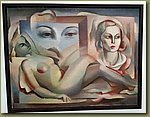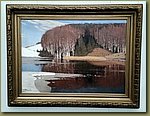Copenhagen |
Estonia |
Latvia |
Lithuania |
Ella&Boris Pictures |

Estonian Art |

Latvian Art |
Vytis Tours is our agency of choice |
Copenhagen |
Estonia |
Latvia |
Lithuania |
Ella&Boris Pictures |

Estonian Art |

Latvian Art |
Vytis Tours is our agency of choice |
Estonia
Rolling hills, forests, lakes, rivers and medieval ruins. Tallinn, one of the Hanseatic League cities has come a long way into the 21st century.
Thanks in part to cruise ship tourism, the walled old city has been restored to a bustling hub of commercialism.
Friendly locals clad in medieval costumes roam about taking pictures with the tourists, giving it somewhat of a "Disney" feel.
The Lutheran and Russian Orthodox cathedrals are well maintained, as are the cobblestone streets. Horse drawn carriages can take you on a tour of the old city,
through the gates, up the hill and finish off by the flower market. The "newer" city has a core of modern high-rise hotels,
modern department stores and appears to be well on the way to developing more urban complexity.
The KUMU contemporary Estonian art museum is exceptional and not to be missed! The museum itself is a modern architectural attraction, rising up from within a hillside.
Thoughtfully curated, the artworks on display range from the late 1800's through the 20th century.
Not far outside the city we visited one of many restored country manors, with lovely manicured grounds and gardens that often host weddings and other affairs.
Tartu - a university town nestled in the lakes region, has an updated vibe. Situated along the river,
the city center has many pubs and shops and while we were there, had a stage set up for a mid-summer festival with music and other performances.
Decorative dragon heads adorn the street lamps giving a festive feel to the cobblestone streets. The university is a block or two from the city center and down the street from one of the older brick churches.
In general, the local people seem to be happy and friendly. According to our guide, the primary exports are commercial machinery and agricultural products.
Outside Tallinn, highways, if you can call them that, are two lanes in both directions. No one is going anywhere fast by car in Estonia. That being said, you have plenty of time to enjoy the countryside as you slowly make your way over the rivers and through the woods.
Latvia
Crossing the border into Latvia is a seamless transition. A gate marks the border, but you basically just roll on through.
Our first stop, Cesis, a smaller city, has a restored dome, lovely park and more low-key atmosphere, although the locals
were enjoying the warm summer nights and looked like they were going somewhere special for dinner/drinks/entertainment,
just not sure where. Riga, the capital and another former Hanseatic League city, is still the cultural center of the Baltics.
Modern buildings and beautifully restored and maintained historic churches abound in this city on the sea. The new glass and steel library
sits along the Daugava river and mirrors the urban center.
A huge market housed in the former zeppelin maintenance hangars is an easy walk from the city center and offers vegetables,
fruits, poultry, fish, meat, baked goods, liquor, clothes and more.
The restored, red-brick Dome Cathedral houses an immense organ and offers acoustically satisfying sound.
Although the Latvian National Art Museum was closed for renovation, some of the outstanding works of Latvian artists were on display at the Riga Bourse.
The Art Nouveau architecture is also a major attraction, distinguishing this city as a UNESCO world heritage site.
Parks and public art installations abound and the city definitely has the most cultural vibe of all the places we visited in the Baltics.
Lithuania
The largest city in the wealthiest of the Baltic countries, Vilnius has an artistic and small town feel.
The main shopping area has all the flair of a cosmopolitan city, mixed in with the historic cathedrals of yore.
Restored alleyways are artistically developed and the peaceful atmosphere belies the tragic history of this city and country.
Sidewalk musicians and open parks abound. Heading to the coast is a slow drive (major highways just aren't to be found in the Baltics).
Klaipeda and the Curonian Spit are summer destinations. Once again, lovely stores and manicured hiking trails make for an easy visit.
The Hill of Witches reminded me of Fengdu in the Yangtze - a little "Disney-ish" with artistic, wood-carved statutes of fairytale characters.
The Hill of Crosses, a stop enroute to Riga, is a striking historical site commemorating Lithuanean patriotism, independence, and resistance.
Baltic Art
By far the best find of the trip was the Latvian and Estonian art! Masterpieces from the late 1800's through the 20th century are on display in Riga and at the KUMU just outside of Tallinn. Impressionist, expressionist, cubist and more influence these less well-known masters. The KUMU is a modern architectural building with a thoughtfully curated collection.
Here are few more random thoughts for future travelers there:
Amber, amber and amber...need we say more :) Many people speak Russian and English, some speak German. As the guide put it: grandparents had to learn German, parents had to learn Russian, and children study English.